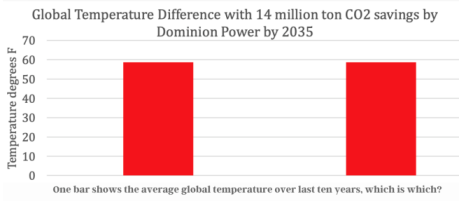"CONCLUSION:
The Virginia Clean Economy Act, with its goal of meeting electric demand with 100% intermittent wind and solar power, may double electric rates.
Residential electric rates may increase from $800 to $1,500 a year, and industrial rates could rise by millions a year.
It will also likely have a negative economic impact of up to $10 to $16.5 billion a year by 2030.
Electric grid reliability will likely be harmed to the point blackouts become inevitable.
Reliable generation falls from 95% to possibly 45%, and reliance on imports from other states grows from 25% to 40%, and this only gets Virginia to 60% of the zero-emission goal.
All of these negative impacts will yield an insignificant impact on climate change.
DETAILS:
Reliance on intermittent wind and solar guarantees rocketing power prices and chaotic supply.
Price spikes and/or power rationing when the sun sets or calm weather sets in are the death knell for a range of energy-hungry businesses and industries.
Manufacturing and mineral processing are usually the first to disappear, when the true costs of running with the unreliables start to bite.
The State of Virginia provides the perfect example, with a push for an all wind and sun powered future in the not-too-distant future.
David Stevenson adds up the whopping costs and the non-existent benefits of Virginia’s plans to run on sunshine and breezes below.
Cost and Reliability Implications
of the Virginia Clean Economy Act
Caesar Rodney Institute
David T Stevenson
10 January 2022
Virginia legislation requires electric power to come 100% from renewable sources by 2045.
Specific targets are set for the amount of solar and onshore wind, offshore wind, and power storage that must be built by two regulated utilities.
This is on top of previous requirements for added demand-side management, grid upgrades, and environmental upgrades.
Dominion Power, which supplies 80% of Virginia’s electric power, filed a plan with the utility commission for meeting certain goals by 2035.
Following the law may double residential electric rates by 2030, adding up to $1,500 a year while reducing electric grid reliability.
The cost increase closely tracks the added capital cost to meet the plan. (Authors note: Since this was written Dominion cut building a $620 million natural gas plant from the plan but added $2 billion in the cost estimate for offshore wind so this analysis may underestimate costs – Updated 1/31/2022).
Capital Investments
Testimony by Carol Meyers of the State Corporation Commission staff (utility commission) lays out the investment impacts and the cost impacts on 2030 electric bills:https://www.caesarrodney.org/pdfs/12.0.Cost_and_reliability_implications_of_VCEA.pdf
Economic Impact
The direct negative economic impact of doubling electric rates in VA by 2030 would be $4.5 to $7.2 billion a year.
Indirect and induced impacts are calculated using a regional multiplier from the US Bureau of Economic Analysis, which is 1.2983 for utilities, or $5.8 to $9.3 billion, for a total annual cost of $10.3 to $16.5 billion a year, all paid by Virginia electric customers.
Much of the one-time investment in grid upgrades goes to out-of-state wind, solar, and battery suppliers.
For example, 56% of the cost of utility-grade solar is for material supplier cost, and there are no suppliers in Virginia.
The capital investment for solar, wind, and storage totals $39.7 billion, so at least 56%, or at least $22 billion, will likely be spent out-of-state.
So, the potential direct development benefit to Virginia from all the investments listed is $35 billion, or $80 billion using the indirect multiplier.
That benefit is wiped out by about five years of higher electricity costs.
Electric rates will move from the middle of the pack in the nation to the upper tier.
Higher electric rates in nine mid-Atlantic and New England states led to Goods Production falling 7% while comparison states grew 20% from 2007 to 2015.
Higher electric rates hit energy-intensive businesses in those states especially hard, with a 34% loss.
The Dominion Power plan assumed electric demand would rise by about 20,000 MWh a year by 2030 for Data Centers, which are one of the most sensitive industries to electric rates.
These new Data Centers would most likely be located nearby in West Virginia where electric rates may be 40% lower.
Goods manufacturing tends to pay high salaries to blue-collar workers.
For example, a steel mill with 375 workers paying $75,000 a year to its union employees in Delaware closed mostly because of high electric rates compared to the company’s facilities elsewhere.
The jobs were replaced at an Amazon fulfillment center, paying half as much.
Impact on Global Warming
The Dominion Power plan saves 14 million metric tons of carbon dioxide emission a year by 2035, down from 25 million in 2019.
The EPA MAGICC model calculates the reduction in global temperatures from such reductions by 2100.
By 2035 the Dominion Power plan will lower global temperatures by 0.002 degrees Fahrenheit, as shown in the below graph.
Impact on Reliability
Dominion Power’s plan is to keep its fleet of natural gas generation power plants for backup, along with a small amount of battery and pumped hydro storage.
Most of those NG facilities were not designed for quick start-ups.
The regional grid manager, PJM, makes capacity payments to keep power plants online if needed, and the most recent auction settled at $50/MW-day or $18,250/year for each MW of capacity.
With 8,413 MWs of capacity, that amounts to about $154 million a year in payments from electric customers just to keep those plants open and another $33 million a year for the new battery and pumped storage backup.
There is no guarantee those NG plants will stay open for those payments.
In 2020 Texas generated 25% of their power with intermittent wind and solar but saw as little as 1.5% contribution from those sources during several days of power blackouts blackouts.
No one has experience with keeping a grid running with 100% reliance on wind and solar."

